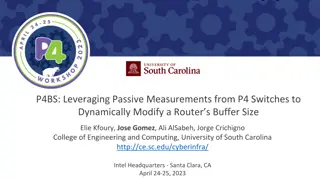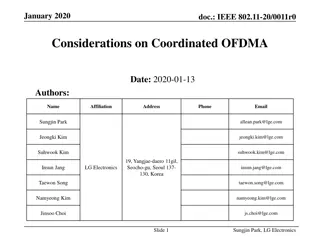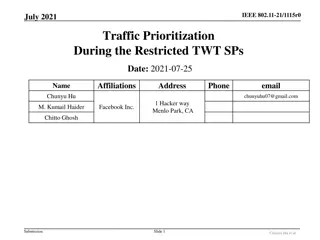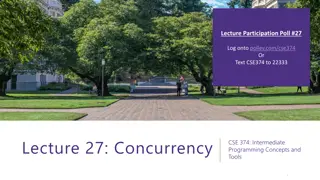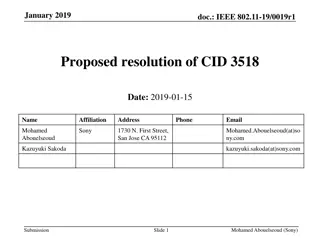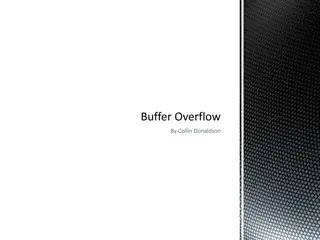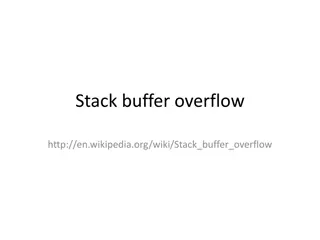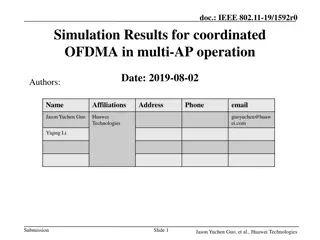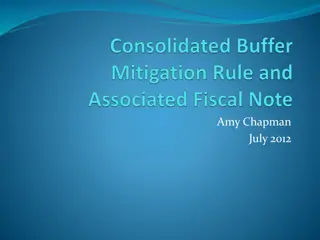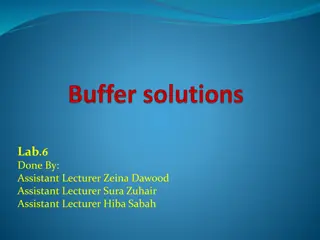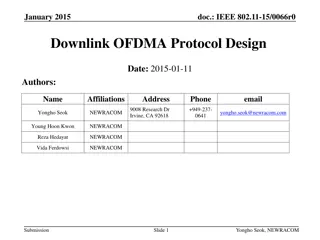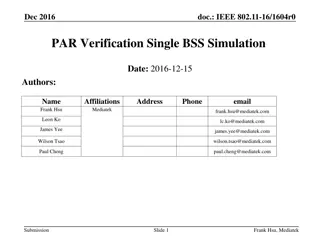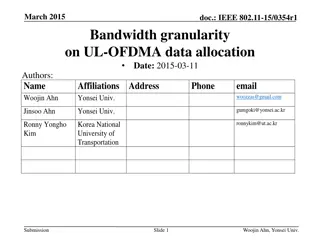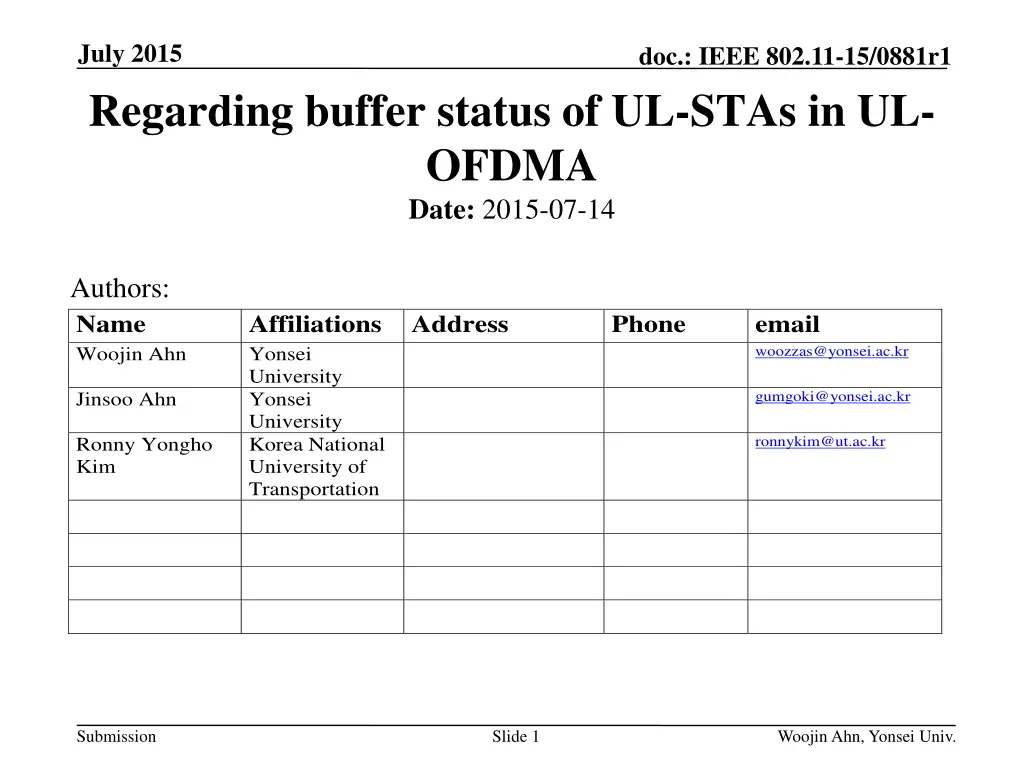
UL-STAs Buffer Status in UL-OFDMA Discussion
Explore the importance of buffer status information for UL-STAs in UL-OFDMA and methods for enhancing efficiency through buffer status reporting and contention isolation. Learn about the implications of lacking buffer status information in UL-OFDMA scenarios.
Download Presentation

Please find below an Image/Link to download the presentation.
The content on the website is provided AS IS for your information and personal use only. It may not be sold, licensed, or shared on other websites without obtaining consent from the author. If you encounter any issues during the download, it is possible that the publisher has removed the file from their server.
You are allowed to download the files provided on this website for personal or commercial use, subject to the condition that they are used lawfully. All files are the property of their respective owners.
The content on the website is provided AS IS for your information and personal use only. It may not be sold, licensed, or shared on other websites without obtaining consent from the author.
E N D
Presentation Transcript
July 2015 Regarding buffer status of UL-STAs in UL- OFDMA Date: 2015-07-14 doc.: IEEE 802.11-15/0881r1 Authors: Name Woojin Ahn Affiliations Address Yonsei University Yonsei University Korea National University of Transportation Phone email woozzas@yonsei.ac.kr gumgoki@yonsei.ac.kr Jinsoo Ahn ronnykim@ut.ac.kr Ronny Yongho Kim Submission Slide 1 Woojin Ahn, Yonsei Univ.
July 2015 doc.: IEEE 802.11-15/0881r1 Introduction Emphasizing the importance of buffer status information of UL-STAs in UL-OFDMA Discussing buffer status report methods using random access UL-OFDMA Submission Slide 2 Woojin Ahn, Yonsei Univ.
July 2015 doc.: IEEE 802.11-15/0881r1 Enhancing the efficiency of UL-OFDMA The more number of assigned STAs per UL-OFDMA session, the more efficiency can be achieved Contention isolation: OFDMA replaces multiple contention periods [1] AP assigns UL-STAs to available RUs with trigger frame It is desirable for AP to secure the information of UL-STAs buffer status information as much as possible Which STAs are having what kind of data? ID, Data length, (AC etc.) Methods for gathering buffer status information hasn t been discussed very much Slide 3 Submission Woojin Ahn, Yonsei Univ.
July 2015 doc.: IEEE 802.11-15/0881r1 UL-OFDMA without buffer status information Without buffer status information Impossible to assign specific STA to RUs AP might open available RUs to let STAs access to randomly chosen RUs AP sends TF for random access with duration of random access UL-Data defined by AP Every UL-Data transmission should be end at the same time Random access of UL-Data might significantly degrade the effective TP of UL-OFDMA Submission Slide 4 Woojin Ahn, Yonsei Univ.
July 2015 doc.: IEEE 802.11-15/0881r1 UL-OFDMA without buffer status information AP AP UL-STA UL-Data (AID 3) Possibility of collisions and no-access The sparser the network, the more number of empty RUs will appear The denser the network, the more collision will occur UL-Data (AID 48) No access TF No access M-BA No access No access UL-Data (AID 73) No access STAs UL-Data (AID 93) AP UL-Data (AID 3) Collision (AID 15, 143) No access TF Collision (AID 295, 34) M-BA Collision (AID 7, 23, 214) Collision (AID 93, 233, 639) UL-Data (AID 73) UL-Data (AID 93) STAs Collision (AID 271, 432, 32) No access Submission Slide 5 Woojin Ahn, Yonsei Univ.
July 2015 doc.: IEEE 802.11-15/0881r1 UL-OFDMA without buffer status information Depending on the variance of UL- Data length, the effective TP of UL- OFDMA might further decrease UL-STAs with shorter UL-Data length should add padding until the longest UL- Data ends The more padding, the less effective TP AP AID 3 AID 48 Padding AID 5 Padding TF Collision M-BA AID 143 Padding No access AID 73 AID 32 STAs AID 93 Submission Slide 6 Woojin Ahn, Yonsei Univ.
July 2015 doc.: IEEE 802.11-15/0881r1 UL-OFDMA without buffer status information In order to reduce the negative effect of padding, AP might force shorter UL-Data length Every UL-Data must be fit into the appointed UL-Data length The total amount of padding will decrease Overall system overhead will increase Requiring more number of UL-OFDMA sessions for the same amount UL-Data AP AP AID 3 AID 3 Overhead increases AID 48 Padding AID 48 AID 5 Padding AID 5 TF Collision M-BA TF Collision M-BA AID 143 Padding AID 143 No access No access M-BA M-BA TF TF AID 73 AID 73 SU UL- Data UL- Data AID 32 AID 32 STAs STAs AID 93 AID 93 Submission Slide 7 Woojin Ahn, Yonsei Univ.
July 2015 doc.: IEEE 802.11-15/0881r1 Buffer status report for UL-OFDMA Buffer status information on AP side will provide more flexibility on RU assignment With STA ID (e.g., AID), collision and no-access RUs can be avoided With data length, padding can be minimized using RU granularity Conventional polling based buffer status report incurs too much overhead [2] 1-bit indication method (e.g., more data in MAC header) AP could obtain only UL-STA IDs, no data length limitation on quality Only STAs who had communicated with AP in the past can be assigned limitation on quantity The validity of information degrades as time passes It is necessary to consider appropriate buffer status reporting methods with reasonable overhead and delay bound Submission Slide 8 Woojin Ahn, Yonsei Univ.
July 2015 doc.: IEEE 802.11-15/0881r1 Buffer status report using UL-OFDMA Random Access (case 1) Buffer status report using UL-OFDMA Random Access UL-OFDMA random access have been introduced in the last meeting[4] Case 1: using novel frame format for Buffer Status Report (BSR) AP sends TF for BSR Request (BSRR) at the beginning of UL-OFDMA session Including BSRR indication (AID for BSRR), RUs for BSR Each UL-STA sends BSR through randomly chosen RU as a response of BSRR AP assigns RUs to UL-STA based on BSR Normal trigger frame for UL-Data will follow the BSR Triggering actual UL-Data transmission AP BSRR TF/ TF M-BA UL-DATA BSR STAs Submission Slide 9 Woojin Ahn, Yonsei Univ.
July 2015 doc.: IEEE 802.11-15/0881r1 Buffer status report using UL-OFDMA Random Access (case 1) More details on RA BSR A new frame format might be defined Recognizable only for ax-STAs Reducing redundant part of MAC header or PHY preamble Minimizing the loss of spectral efficiency from collision or no-access Containing only essential information for RU assignment ID, data length Other parameters (e.g., AC) might be included AP might open RUs for BSR over multiple channels Available channel with AP s perspective Collided BSR could be regarded as contention failure The following TF might take a role of acknowledgement for BSR AP may choose whether it send BSRR or not Considering its UL-STA pool AID, AC, Length 3, AC0, xx bytes 158, AC2, xx bytes Primary BSR collision 245, AC1, xx bytes Secondary BSR collision 1 37, AC3, xx bytes Secondary BSR 1517, AC1, xx bytes 2 27, AC2, xx bytes Secondary BSR collision 3 Submission Slide 10 Woojin Ahn, Yonsei Univ.
July 2015 doc.: IEEE 802.11-15/0881r1 Buffer status report using UL-OFDMA Random Access (case 2) Case 2: Inserting buffer status information into UL-Data Starting with short random access UL-OFDMA by TF of AP AP doesn t limit the use of random access RU STAs could send either management frame or UL-Data AP defines the RA UL-Data length considering common UL short frames E.g., association, probe request UL STAs randomly accessing RUs insert remaining data length in their buffer into their transmitting UL-Data Existing header field can be reused (e.g., QoS control field in MAC header [3]) Inserting the length information after the body of UL-Data Hdr FCS Data UL-Data of AID x yy bytes remained or Hdr FCS Data Submission Slide 11 Woojin Ahn, Yonsei Univ.
July 2015 doc.: IEEE 802.11-15/0881r1 Buffer status report using UL-OFDMA Random Access (case 2) (continued) Following the random access UL-OFDMA, AP triggers additional UL- OFDMA with specific RU assignment based on gathered buffer status information UL-Data Assn. req. M-BA TF-R UL-Data UL-Data Assn. req. Collision TF UL-Data UL-Data UL-Data Submission Slide 12 Woojin Ahn, Yonsei Univ.
July 2015 doc.: IEEE 802.11-15/0881r1 Conclusion Insufficient information of UL-STAs buffer status might degrade the efficiency of UL-OFDMA In terms of overhead and effective TP It is necessary to consider appropriate buffer status reporting methods with reasonable overhead and delay bound Buffer status report based on random access could be considered as one of the solutions Submission Slide 13 Woojin Ahn, Yonsei Univ.
July 2015 doc.: IEEE 802.11-15/0881r1 Reference [1] 11-14-1442-01-00ax-considerations-on-dl-ofdma- control-mechanism [2] 11-14-1431-00-00ax-issues-on-ul-ofdma [3] 11-15-0608-01-00ax-regarding-trigger-frame-in-ul-mu Submission Slide 14 Woojin Ahn, Yonsei Univ.
July 2015 doc.: IEEE 802.11-15/0881r1 Straw poll #1 Do you agree with the necessity of buffer status report of UL-STAs as part of a UL-OFDMA procedure? Y N A Submission Slide 15 Woojin Ahn, Yonsei Univ.
July 2015 doc.: IEEE 802.11-15/0881r1 Straw poll #2 Do you agree with random access based UL-OFDMA for UL-STAs buffer status report? Y N A Submission Slide 16 Woojin Ahn, Yonsei Univ.

